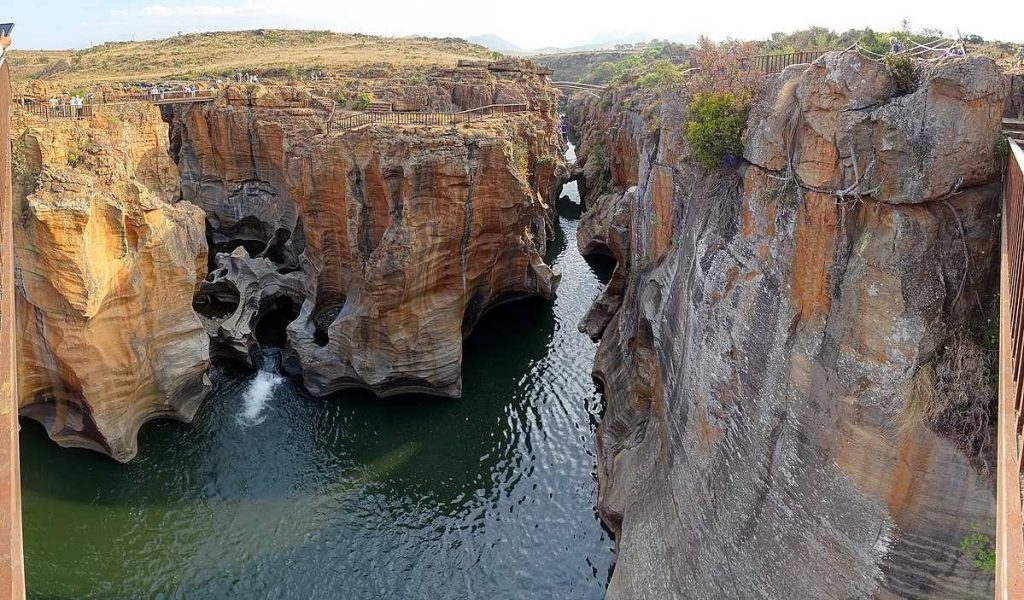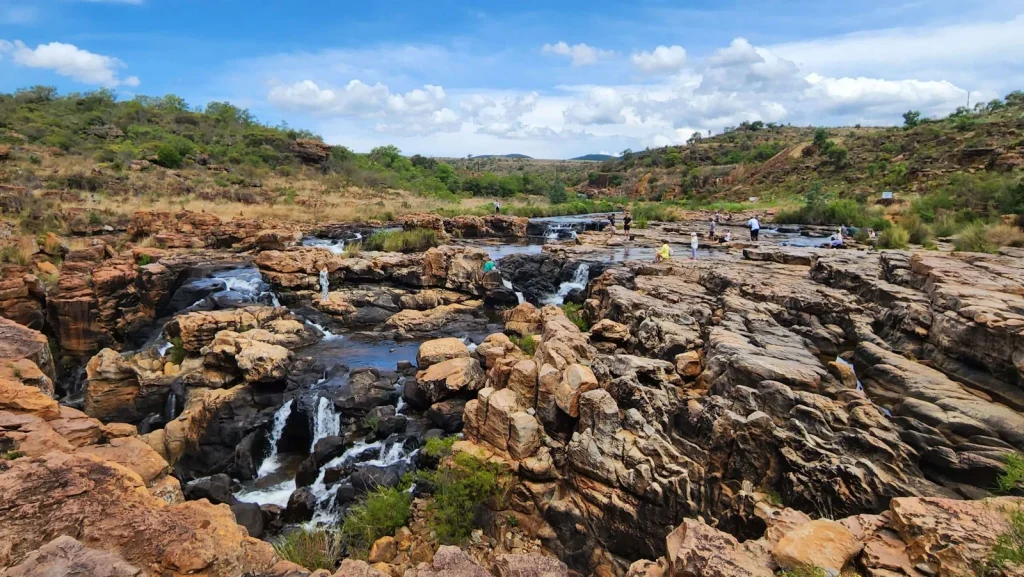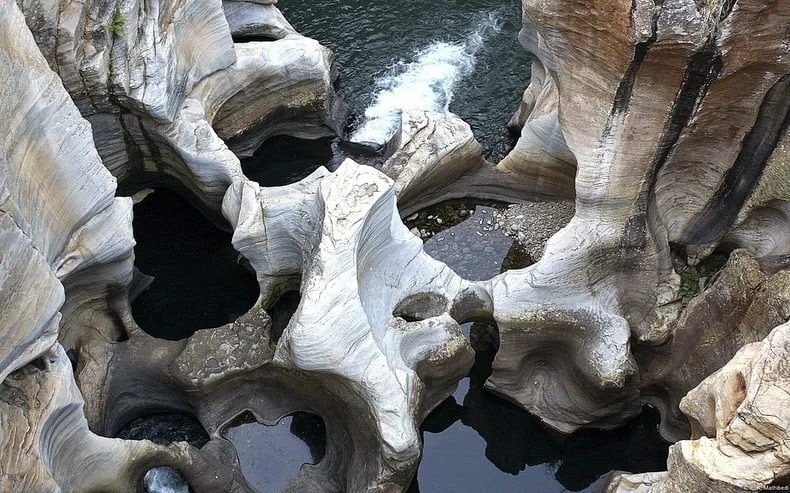South Africa’s Natural and Historical Wonders: Bourke’s Luck Potholes, Cape Dutch Homesteads, and the Cradle of Humankind
Bourke’s Luck Potholes is a geological formation and a popular tourist attraction located in the Mpumalanga province of South Africa. Here are key points about Bourke’s Luck Potholes:
- Location:
- Bourke’s Luck Potholes is situated at the confluence of the Treur River and the Blyde River, near the town of Graskop in Mpumalanga, South Africa.
- Formation:
- The potholes were formed through natural geological processes over centuries. Erosion and swirling water currents caused by the meeting of the two rivers led to the creation of cylindrical pothole-like structures in the rocks.

- Unique Geological Features:
- The potholes are characterized by cylindrical and smooth-sided formations carved into the rock, resembling giant potholes. These formations are a result of the abrasive action of pebbles and swirling water.
- Named After Prospector:
- The name “Bourke’s Luck” is derived from a local prospector, Tom Bourke, who discovered gold in the area during the gold rush. However, he was apparently not lucky enough to find a significant gold deposit.

- Scenic Beauty:
- Bourke’s Luck Potholes is known not only for its geological interest but also for its scenic beauty. The unique rock formations, combined with the flowing rivers and surrounding vegetation, create a picturesque landscape.
- Footbridges and Viewpoints:
- To allow visitors to appreciate the potholes and the surrounding landscape, a series of footbridges and viewpoints have been constructed. These structures provide safe access and panoramic views of the natural wonders.
- Blyde River Canyon Nature Reserve:
- Bourke’s Luck Potholes is located within the Blyde River Canyon Nature Reserve, which is known for its diverse flora and fauna. The reserve is part of the Drakensberg escarpment.

- Visitor Center:
- There is a visitor center near Bourke’s Luck Potholes, providing information about the geological processes that created the formations and the natural features of the surrounding area.
- Hiking Trails:
- The Blyde River Canyon Nature Reserve offers hiking trails for those who want to explore the scenic beauty and wildlife of the region further.
- Tourist Attraction:
- Bourke’s Luck Potholes is a popular stop for tourists exploring the Panorama Route in Mpumalanga. The Panorama Route offers breathtaking views of natural landmarks, including God’s Window and the Three Rondavels.

Entrance fees – R130 per adult for foreign citizens.
Bourke’s Luck Potholes are unquestionably a prominent emblem, however when they are paired with sights like the Three Rondawels, God’s Window, the Blyde River Canyon, and other spectacular waterfalls, one can eventually grow numb to them
Bourke’s Luck Potholes is not only a geological marvel but also a place of scenic allure, drawing visitors to witness the fascinating rock formations shaped by the forces of nature.
Explore The Cape Dutch Homesteads – One of South Africa Historic Architectural Treasures
The Cape Dutch homesteads of the Winelands, located in the Western Cape of South Africa, are historic architectural treasures that reflect the region’s rich cultural and agricultural heritage. Here are key points about these distinctive homesteads:
- Architectural Style:
- Cape Dutch architecture is characterized by its unique design elements, which were influenced by the early Dutch settlers in the Cape Colony during the 17th and 18th centuries.
- Key features include a distinctive H-shape or U-shape layout, whitewashed walls, thatched or gabled roofs, and ornate gables with curved edges.
- Historical Context:
- The Cape Dutch homesteads are closely tied to the history of European settlement in the Cape of Good Hope, particularly the Dutch East India Company’s establishment of a refreshment station in the mid-1600s.
- The homesteads were initially built as residences for European colonists, farmers, and landowners.
- Vineyard Setting:
- Many Cape Dutch homesteads are situated in the Winelands, a region known for its vineyards and wine production. The homesteads often form an integral part of wine estates.
- Gardens and Grounds:
- These homesteads typically feature well-maintained gardens with indigenous plants, vineyards, and orchards. The layout of the gardens is often symmetrical and complemented by pathways and water features.

- Gabled Facades:
- Gables are a prominent feature of Cape Dutch architecture, and the gabled facades of these homesteads are often adorned with decorative elements such as scrolls, finials, and geometric patterns.
- The gables serve both functional and ornamental purposes, providing shade and contributing to the aesthetic appeal.
- Thick Walls and Small Windows:
- The thick walls of Cape Dutch homesteads served as insulation against the region’s hot summers and cool winters.
- Windows were relatively small, contributing to temperature control and security.
- Preservation Efforts:
- Efforts have been made to preserve and restore Cape Dutch homesteads, recognizing their cultural and historical significance.
- Some homesteads are open to the public, allowing visitors to experience the architectural beauty and learn about the history of the structures.
- Heritage Route:
- The Cape Dutch architecture in the Winelands is often explored through heritage routes, where visitors can follow designated paths to encounter various homesteads and historical sites.

- Cultural Tourism:
- Cape Dutch homesteads contribute to cultural tourism in the Western Cape, attracting visitors interested in history, architecture, and the scenic landscapes of the Winelands.
- Wine Tasting and Events:
- Many wine estates with Cape Dutch homesteads offer wine tasting experiences, cultural events, and tours, providing visitors with a holistic understanding of the region’s heritage.
The Cape Dutch homesteads of the Winelands stand as enduring symbols of South Africa’s colonial history and architectural ingenuity. They continue to captivate visitors with their charm, historical significance, and contribution to the cultural identity of the Western Cape.
Key Details about The Cradle of Humankind – A UNESCO World Heritage Site in Gauteng SA.
The Cradle of Humankind is a UNESCO World Heritage Site located in the Gauteng province of South Africa. Here are key details about the Cradle of Humankind:
- Location:
- The Cradle of Humankind is situated about 50 kilometers northwest of Johannesburg, near the towns of Krugersdorp and Magaliesburg.
- UNESCO World Heritage Site:
- Designated as a UNESCO World Heritage Site in 1999, the Cradle of Humankind is recognized for its outstanding contribution to our understanding of human evolution and the development of early human societies.
- Fossil Hominid Sites:
- The site is renowned for its wealth of fossil hominid (early human) remains, providing crucial insights into the evolutionary history of Homo sapiens.
- Numerous caves and excavation sites within the Cradle of Humankind have yielded fossilized remains dating back millions of years.
- Sterkfontein Caves:
- One of the most famous sites within the Cradle of Humankind is the Sterkfontein Caves. These caves have produced some of the most significant hominid fossils, including the famous “Mrs. Ples” and “Little Foot.”

- Maropeng Visitor Centre:
- The Maropeng Visitor Centre serves as the main entrance to the Cradle of Humankind. It is an award-winning facility that offers educational exhibits, interactive displays, and multimedia presentations on human evolution.
- The center also features the Tumulus Building, an architectural marvel housing the exhibition on the origin of humans.
- Magaliesberg Biosphere Reserve:
- The Cradle of Humankind is part of the larger Magaliesberg Biosphere Reserve, contributing to the conservation of biodiversity and the natural environment.
- Ancient Landscapes:
- The region is characterized by a diverse landscape, including limestone caves, dolomite sinkholes, and scenic grasslands.
- It provides a glimpse into the ancient environments that shaped the development of early humans.

- Ongoing Discoveries:
- Ongoing archaeological and paleontological research continues to uncover new findings and contribute to our understanding of the evolution of Homo sapiens.
- Tourist Attractions:
- In addition to the Sterkfontein Caves and Maropeng Visitor Centre, the Cradle of Humankind offers other tourist attractions and activities such as hot air balloon rides, wildlife encounters, and outdoor adventures.
- Educational and Scientific Significance:
- The Cradle of Humankind plays a crucial role in advancing scientific knowledge about human evolution, and it serves as an educational resource for visitors interested in paleontology, anthropology, and archaeology.
- Cultural Heritage:
- The site not only preserves the natural heritage of early human history but also recognizes the cultural significance of the area for local communities.

The Cradle of Humankind stands as a testament to the evolutionary journey of humanity, offering a unique and immersive experience for those interested in exploring our shared ancestry and the origins of Homo sapiens.
Add a Comment
You must be logged in to post a comment.

